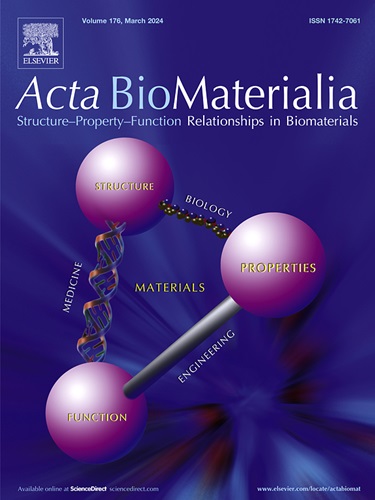Heterogeneity in cranial dura mater at the microscale: An In-situ and ex-vivo structural and mechanical investigation of sulcus and gyrus Dura
IF 9.4
1区 医学
Q1 ENGINEERING, BIOMEDICAL
引用次数: 0
Abstract
This study examines cranial dura mater's structural and mechanical heterogeneity, focusing on the distinct properties between the sulcus and gyrus regions. Microscale analyses using two-photon microscopy and atomic force microscopy (AFM) revealed significant regional differences in thickness (p < 0.05), with sulcus dura being 1.34 times thicker than gyrus dura. Differences in effective Young's modulus were observed, with values of 6.75 ± 5.12 kPa in the sulcus and 10.48 ± 7.13 kPa in the gyrus. These findings highlight the dura mater's pronounced variability in stiffness and anisotropy, with the periosteal layer being substantially stiffer than the meningeal layer. These results underscore the critical role of collagenous architecture in determining dura's mechanical behavior, particularly in the transfer of loads across the brain. This study provides valuable insights into the functional heterogeneity of the dura mater and emphasizes the importance of these variations in the design of biomimetic dural grafts. The quantitative data generated in this study has significant implications for enhancing the biofidelity of computational models used in brain biomechanics and advancing tissue engineering strategies to develop dural substitutes.
Statement of Significance
This study presents a comprehensive analysis of the structural and mechanical heterogeneity of cranial dura mater at the nanoscale, focusing on the differences between sulcus and gyrus regions. By employing advanced techniques such as atomic force microscopy (AFM) and two photon microscopies, the findings are crucial for understanding the dura's protective functions and its role in load transfer across the brain. The implications of this study are significant for the development of biomimetic dural grafts, as it offers detailed quantitative data necessary for designing grafts that closely mimic the native dura's structural and mechanical. Additionally, this research could help develop more accurate finite element models (FEM) to study traumatic brain injuries (TBI) and brain dynamics.

显微尺度下颅硬脑膜的异质性:硬脑膜沟和硬脑膜回的原位和离体结构和力学研究。
本研究探讨了颅硬脑膜的结构和力学异质性,重点研究了脑沟区和脑回区的不同特性。双光子显微镜和原子力显微镜(AFM)的微尺度分析显示,硬脑膜沟厚度是硬脑膜回厚度的1.34倍,具有显著的区域差异(p < 0.05)。有效杨氏模量差异较大,脑沟为6.75±5.12 kPa,脑回为10.48±7.13 kPa。这些发现突出了硬脑膜在硬度和各向异性方面的显著变异性,骨膜层比脑膜层硬得多。这些结果强调了胶原结构在决定硬脑膜力学行为中的关键作用,特别是在整个大脑的负荷转移中。本研究对硬脑膜的功能异质性提供了有价值的见解,并强调了这些差异在仿生硬脑膜移植物设计中的重要性。本研究中产生的定量数据对于增强脑生物力学中使用的计算模型的生物保真度和推进组织工程策略以开发硬脑膜替代品具有重要意义。意义声明:本研究在纳米尺度上全面分析了颅硬脑膜的结构和力学异质性,重点研究了脑沟区和脑回区之间的差异。通过使用原子力显微镜(AFM)和双光子显微镜等先进技术,这些发现对于理解硬脑膜的保护功能及其在大脑负荷转移中的作用至关重要。本研究的意义对于仿生硬脑膜移植物的发展具有重要意义,因为它为设计接近模拟天然硬脑膜结构和力学的移植物提供了必要的详细定量数据。此外,该研究有助于开发更精确的有限元模型来研究创伤性脑损伤(TBI)和脑动力学。
本文章由计算机程序翻译,如有差异,请以英文原文为准。
求助全文
约1分钟内获得全文
求助全文
来源期刊

Acta Biomaterialia
工程技术-材料科学:生物材料
CiteScore
16.80
自引率
3.10%
发文量
776
审稿时长
30 days
期刊介绍:
Acta Biomaterialia is a monthly peer-reviewed scientific journal published by Elsevier. The journal was established in January 2005. The editor-in-chief is W.R. Wagner (University of Pittsburgh). The journal covers research in biomaterials science, including the interrelationship of biomaterial structure and function from macroscale to nanoscale. Topical coverage includes biomedical and biocompatible materials.
 求助内容:
求助内容: 应助结果提醒方式:
应助结果提醒方式:


